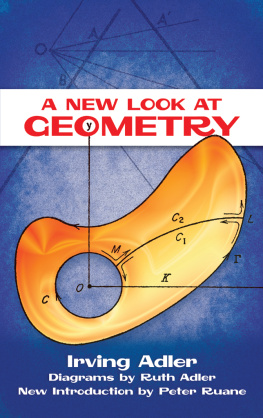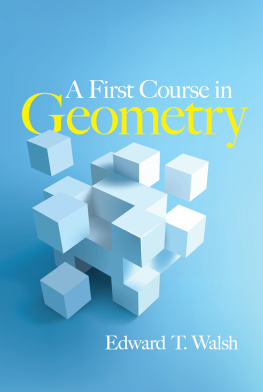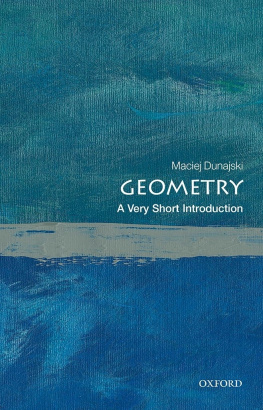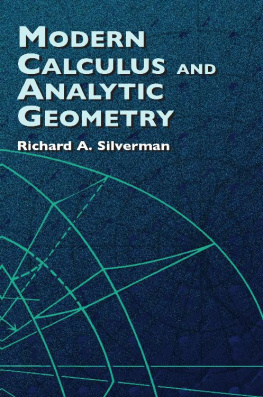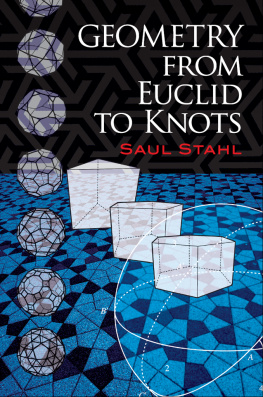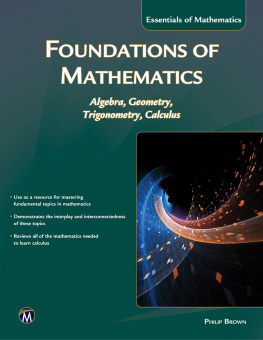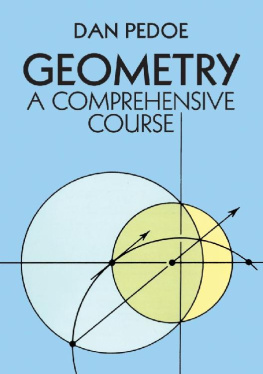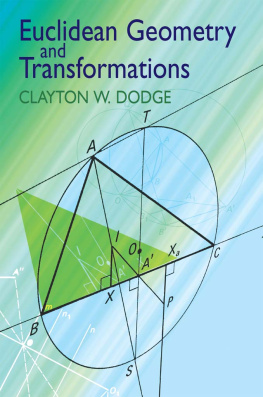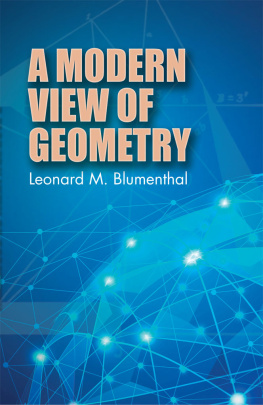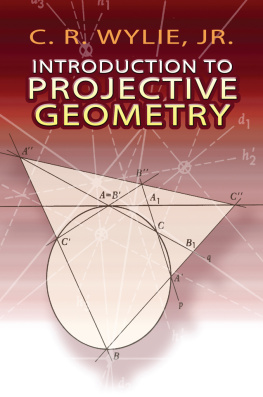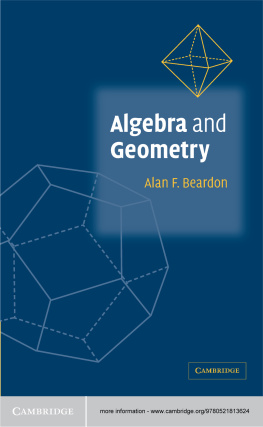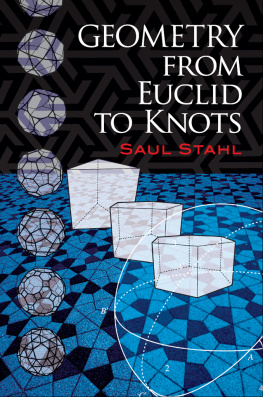DOVER PUBLICATIONS, INC.
Mineola, New York
The English translation of Gausss letter to Taurinus is by Professor Harold E. Wolfe, and is reproduced from his book Non-Euclidean Geometry with the permission of Professor Wolfe and the publishers, Holt, Rinehart & Winston.
This Dover edition, first published in 2012, is an unabridged republication of the work originally published by The John Day Company, New York, in 1966. A new Introduction to the Dover edition, written by Peter Ruane, has been specially prepared for the present volume.
Adler, Irving.
introduction to the Dover edition by Peter Ruane. Dover ed.
p. cm.
Originally published: New York : John Day Co., 1966.
Includes bibliographical references and index.
1.Geometry. I. Title.
Introduction to the Dover Edition
When it was first published in the USA by The John Day Company in 1966, this was, to my knowledge, the first book to provide an accessibly broad description of classical and modern geometries. Since then, similar books on geometry have appeared, but they assume a higher level of mathematical expertise on the part of the reader, and the scope of their contents is somewhat narrower. Consequently, I believe this book retains its uniqueness in the above sense. On the other hand, I have never understood why it became out of print, while many lesser texts remained in circulation.
Suited to readers of high school standard and above, A New Look at Geometry describes the emergence of geometrical ideas from the ancient Egyptians to the work of Bolyai, Lobachevsky, and Felix Klein. One of the books central themes is the relationship between physical space and the geometries that represent it. In other words, it relates Euclidean geometry to Newtonian physics, and it explains the relevance of non-Euclidean geometry to relativity.
The work of Descartes and Fermat form the context for the development of another of the books major themesthe relationship between algebra and geometry. Coordinates, vector algebra, isometries, and symmetry groups are shown to be effective geometric tools and, following subsequent introductions to non-Euclidean and projective geometry, the importance of Kleins Erlanger Programme is considered. However, because this is an introductory survey of geometries that is intended for non-specialists, Irving Adler has avoided undue reference to mathematical technicalities.
The central chapters explain how the theory of parallels, the theory of curved surfaces and the geometry of position jointly form the basis of modern geometry. Saccheri, Lambert, and Legendre are the main characters in the drama of Euclids parallel postulate, while the work of Gauss, Bolyai, and Lobachevsky characterize its denouement. The relevance of Hilberts axioms to Euclidean and non-Euclidean geometry is also clarified. Projective geometry is approached algebraically and synthetically, and the chapter Calculus and Geometry offers a highly intuitive survey of elementary differential geometry that leads to the notion of Gaussian curvature and the concept of a manifold.
A New Look at Geometry was written on the basis of sound educational principles that are clearly spelled out in the first chapter (One Book and Three Metaphors). In practice, this means that each of the books important geometric themes are introduced in such a way that anyone with a knowledge of high school mathematics can gain at least a basic understanding of them. It also means that there is no fragmentation of the books contents, because each of the different geometries is shown to be interconnected. However, although Irving Adler states that this book is not a history of geometry, the all-pervading historical observations add to the coherence of the narrative.
Fortunately, nothing about this book has changed since it first appeared and, in this respect, one should apply the dictum If it aint broke, dont fix it. What has changed, however, is the world around it. That is to say, compared to the late 1960s, there are now far more books on particular geometrical themes that have been written for school and university usage. For example, there are numerous texts on non-Euclidean geometry for use at the lower undergraduate level, and differential geometry has long been a standard subject at later stages. Other publications deal with the foundations of geometry, and thereby expose the logical flaws in Euclid. However, at a very accessible level, Irving Adler provides an introduction toand an overviewof all such aspects of geometry. And yet, despite the clarity of the exposition, and the carefully considered presentation of its contents, there is no hint of oversimplification. As such, this book constitutes a serious challenge to the reader.
It is obvious that Irving Adler has a deep understanding of geometry and its history. Moreover, it is clear that, in his day, he was a first-rate teacher, and I would imagine that he was able to teach across a wide range of abilities. Consistent with this belief is the fact that he is the author of fifty-six books (some under the pen name Robert Irving). These are about mathematics, science, and education; but he is also the co-author of thirty others, for both children and adults. His books have been published in thirty-one countries in nineteen different languages.
P ETER R UANE
February 2012
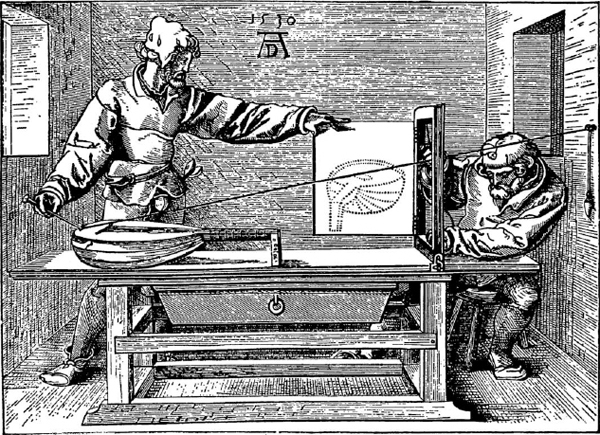
(See )
1
One Book and Three Metaphors
The purposes of this book may be expressed in terms of three metaphors.
The Gem
From the moment he is born a child begins to explore his environment by seeing and hearing it, by moving around in it, and by touching and manipulating things. Out of these explorations there crystallize his first primitive notions of space and the existence of objects in space. Through his daily experience he acquires conceptions of size and shape and distance. When he goes to school he refines these conceptions by absorbing into his experience some of the ideas about space created by inventive minds in the past. At first he studies geometry informally, with emphasis on mensuration. Later, in high school, he gets a brief introduction to Euclidean geometry as a deductive mathematical system. If he goes on to college he learns of new aspects of geometry presented under the titles Analytic Geometry and Calculus. He may hear hints, too, of other mysterious divisions of geometry that only the specialist penetrates: non-Euclidean Geometry, Projective Geometry, Topology, and others. If he is one of the lucky specialists, he discovers that geometry is a many-faceted gem cut and polished from the raw material of our daily experience. One purpose of this book is to permit the reader to share the pleasure of the specialist as he turns this gem in the light and catches the brilliant flashes of color reflected from its facets.

